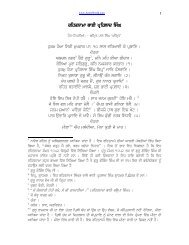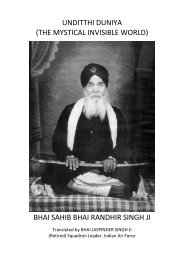Guru Gobind Singh's Death at Nanded Examination of - Vidhia.com
Guru Gobind Singh's Death at Nanded Examination of - Vidhia.com
Guru Gobind Singh's Death at Nanded Examination of - Vidhia.com
You also want an ePaper? Increase the reach of your titles
YUMPU automatically turns print PDFs into web optimized ePapers that Google loves.
44 AN EXAMINATION OF SUCCESSION THEORIES<br />
Emperor Bahadur Shah to the Deccan] by a P<strong>at</strong>han soldier and<br />
he died <strong>of</strong> his wounds in 1708 <strong>at</strong> the town <strong>of</strong> Nandere without<br />
leaving any male issue; and a tradition delivered to the Sicques,<br />
limiting their priests to the number <strong>of</strong> ten, induced them<br />
to appoint no successors to Govind Sing.<br />
[Vol. I, pub. 1798, p. 263.]<br />
Talking about the change in the inscription on the<br />
Sikh coins, Major James Browne has casually referred to <strong>Guru</strong><br />
Nanak and <strong>Guru</strong> <strong>Gobind</strong> Singh as the first and the last<br />
<strong>Guru</strong>s <strong>of</strong> the Sikhs, respectively, and has indirectly given us<br />
the confirmed belief <strong>of</strong> the Sikhs <strong>of</strong> about 1787-88. He<br />
says in his History <strong>of</strong> the Origin and Progress <strong>of</strong> the Sicks,<br />
published in 1788 :<br />
...but after they had been current about fifteen years, the<br />
grand Diet <strong>of</strong> the Sick chiefs (called Goormutta) determined to<br />
call in all those rupees, and to strike them in the names <strong>of</strong><br />
Goowo Nanuck and Gooroo <strong>Gobind</strong> Singh, the first and last<br />
<strong>of</strong> their Gooroos or religious leaders. [ Pp. vi-vii.]<br />
In referring to the historians <strong>of</strong> the nineteenth century,<br />
we would prefer to mention <strong>at</strong> first the Indian writers who<br />
should presumably be better informed about the Sikh <strong>Guru</strong>s<br />
than Europeans. It may, however, be mentioned th<strong>at</strong> some<br />
<strong>of</strong> the Indian writers wrote their books <strong>at</strong> the instance <strong>of</strong><br />
Europeans who were <strong>at</strong> this time feeling interested in the<br />
history and religion <strong>of</strong> the Sikhs with whom they expected to<br />
<strong>com</strong>e in close political contact in the near future. For this<br />
purpose they desired to obtain as correct and reliable<br />
inform<strong>at</strong>ion as possible.<br />
Khushwaqt Rai's Tarlkh-i-Sikhan, also called the<br />
Kitab-i-Tawarikh-i-Panjab, was written in 1811. Therein he<br />
says th<strong>at</strong> "<strong>at</strong> Afzal (Abchal) Nagar [<strong>Nanded</strong>] the <strong>Guru</strong> purchased<br />
a piece <strong>of</strong> land and moved in all happiness from this<br />
transitory world to the world Eternal. The disciples <strong>of</strong> the<br />
<strong>Guru</strong> collected from all sides and crem<strong>at</strong>ed his dead body with<br />
aloe and sandalwood with all the necessary rites. This event,<br />
th<strong>at</strong> is his de<strong>at</strong>h, took place on K<strong>at</strong>ik Sudi 5, 1765 Bikrami.<br />
The gener<strong>at</strong>ion (<strong>of</strong> <strong>Guru</strong>s) <strong>of</strong> <strong>Guru</strong> Nanak up to <strong>Guru</strong> <strong>Gobind</strong><br />
Singh came to an end, [Pp. 36 b -37 a, Appendix XVIII, viii.]<br />
GURU GOBIND SINGH's DEATH AT NANDED 45<br />
In 1233 al-Hijri, 1817^18 A.D. was <strong>com</strong>pleted Ahmed<br />
Shah B<strong>at</strong>alia's Tawarikh-i-Hind : Bayan-i-Ahwal-i-Mulk-i-<br />
Hind-wa-Maluk-i-an az Zumani-qadim ta 1233 Hijri, a part <strong>of</strong><br />
which, the Zikr-i-GurMn wa ibtida-i-Singhdn wa Mazhab-ieshdn,<br />
forms an appendix to Daftar I and II <strong>of</strong> the Umd<strong>at</strong>-ut-<br />
Tawdrikh by Munshi Sohan Lai Suri. In it Ahmed Shah<br />
tells us th<strong>at</strong> <strong>Guru</strong> <strong>Gobind</strong> Singh, who had ac<strong>com</strong>panied Emperor<br />
Bahadur Shah to the Deccan, died <strong>at</strong> <strong>Nanded</strong> in 1765<br />
Bikrami, 1708 A.D., and th<strong>at</strong> the place was known as Abchal<br />
Nagar. He says th<strong>at</strong> some Sikhs also lived there, and th<strong>at</strong> the<br />
Nizam <strong>of</strong> Hyderabad had fixed a daily allowance for them.<br />
In addition to it, Maharaja Ranjit Singh also made<br />
handsome don<strong>at</strong>ions for the upkeep <strong>of</strong> the sanctuary and the<br />
maintenance <strong>of</strong> its custodians. [P. 11, Appendix XVIII, ix.]<br />
The Umd<strong>at</strong>-ut-Tawdrikh <strong>of</strong> Lala Sohan Lai Suri is a<br />
very important work on the the reign <strong>of</strong> Maharaja Ranjit<br />
Singh and his successors up to 1849. Although its first volume<br />
dealing with the <strong>Guru</strong> and the Misal periods was published in<br />
1885, it was originally begun in the form <strong>of</strong> notes somewhere<br />
in the middle <strong>of</strong> the eighteenth century during the time <strong>of</strong><br />
Sohan Lai Suri's grandf<strong>at</strong>her and f<strong>at</strong>her Lala Hakum<strong>at</strong> Rai<br />
and Lala Ganp<strong>at</strong> Rai. It tells us th<strong>at</strong> during the last moments<br />
<strong>of</strong> <strong>Guru</strong> <strong>Gobind</strong> <strong>Singh's</strong> life a disciple <strong>of</strong> his asked him as to<br />
whom he had appointed as <strong>Guru</strong> after him. Thereupon the <strong>Guru</strong><br />
replied th<strong>at</strong> "the <strong>Guru</strong> is Granth ji. There is no difference<br />
between the Granth and the <strong>Guru</strong>. From the darshan <strong>of</strong><br />
Granth ji one shall have the happy darshan <strong>of</strong> the <strong>Guru</strong> Sahib."<br />
[Vol. I, pp. 64-65 Appendix XVIII, x.]<br />
So intense was the faith <strong>of</strong> Maharaja Ranjit Singh in<br />
<strong>Guru</strong> <strong>Gobind</strong> Singh and so ardent was his desire to raise a<br />
befitting memorial on his last resting place <strong>at</strong> <strong>Nanded</strong> th<strong>at</strong> he<br />
occasionally sent large sums <strong>of</strong> money and a number <strong>of</strong> his<br />
men for the purpose all the way from the Panjab. The name<br />
<strong>of</strong> one Sardar Chanda Singh is mentioned in the Umd<strong>at</strong>-ut-<br />
Tawdrikh (Vol. Ill, part iii, p. 355) as having been deputed by<br />
him on the 1st <strong>of</strong> Magh, 1893 Bikrami, to proceed to Abchalnagar<br />
with twenty-five thousand rupees, with promise to remit




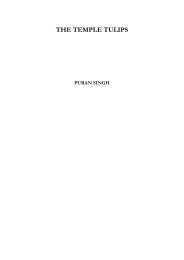
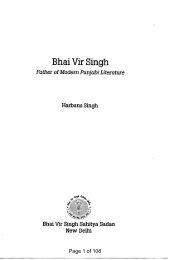

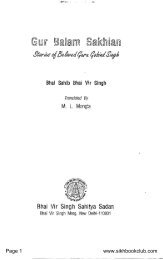
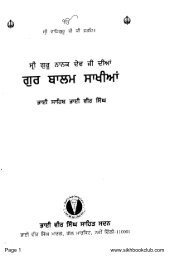
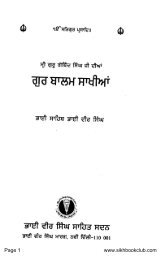
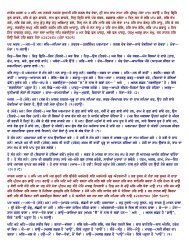
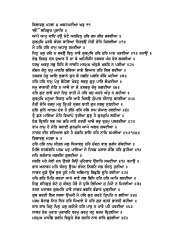

![cOpeI ] hmrI kro hwQ dY r~Cw ] pUrn hoie ic~q kI ie ... - Vidhia.com](https://img.yumpu.com/12240258/1/190x245/copei-hmri-kro-hwq-dy-rcw-purn-hoie-icq-ki-ie-vidhiacom.jpg?quality=85)
